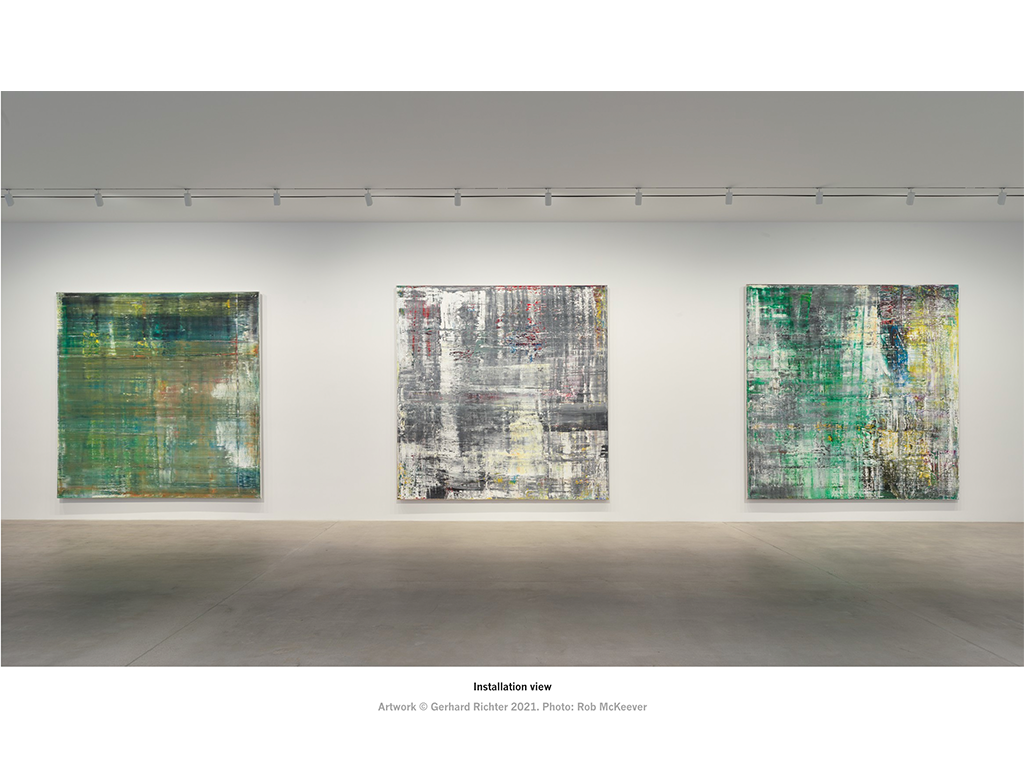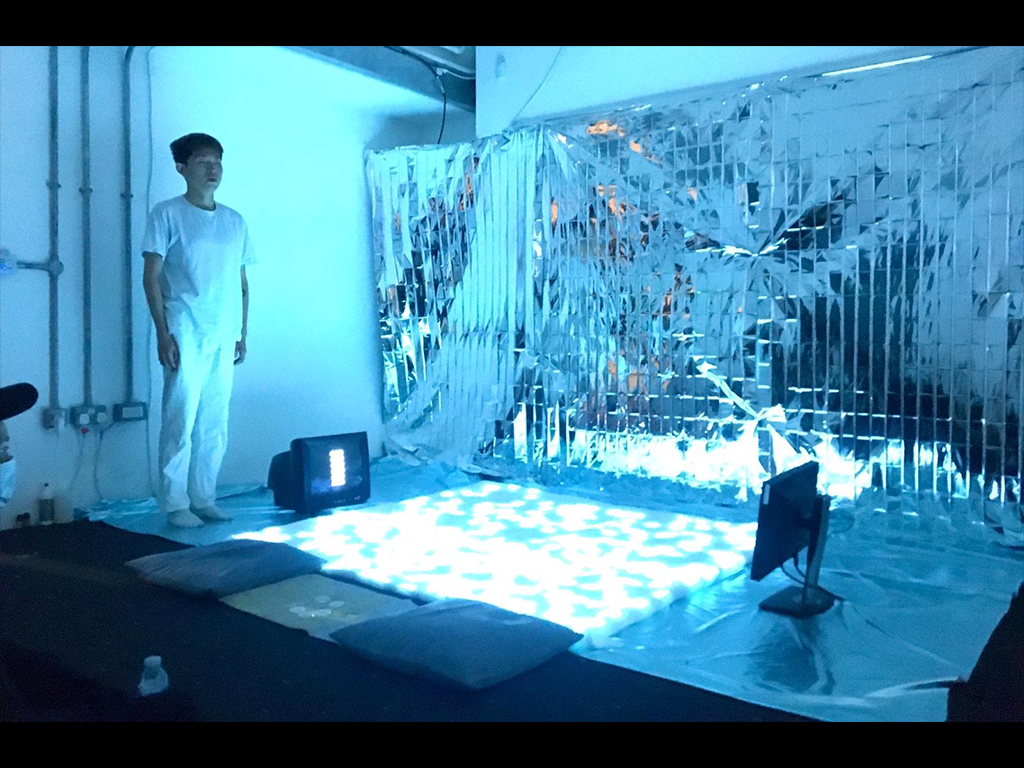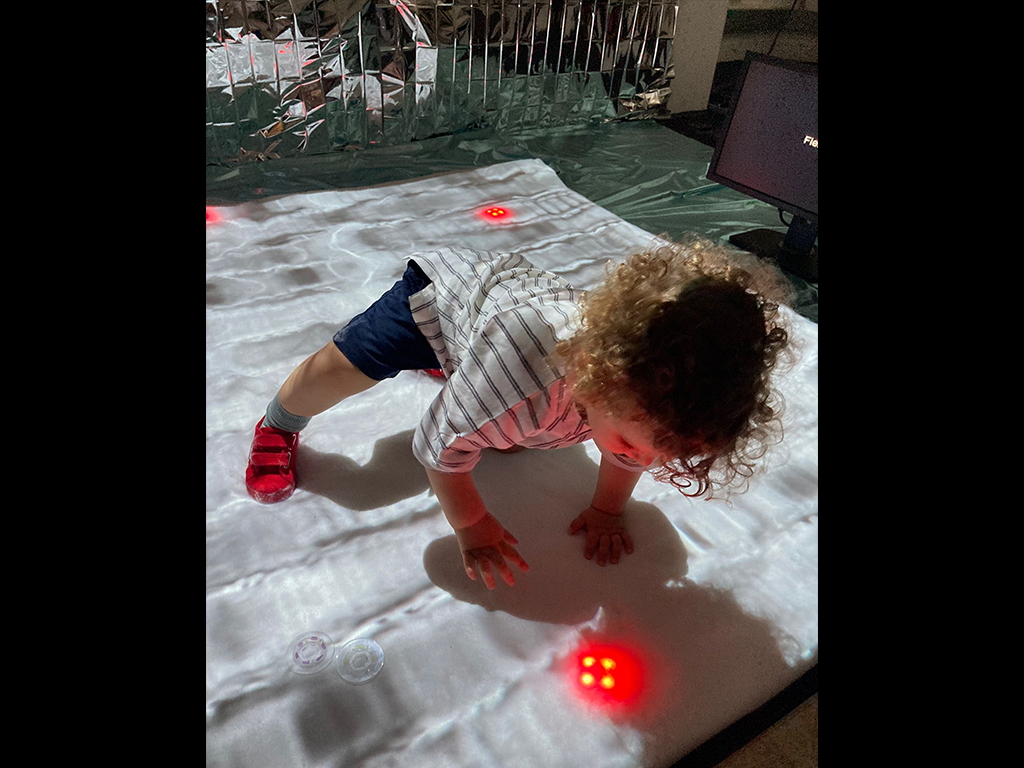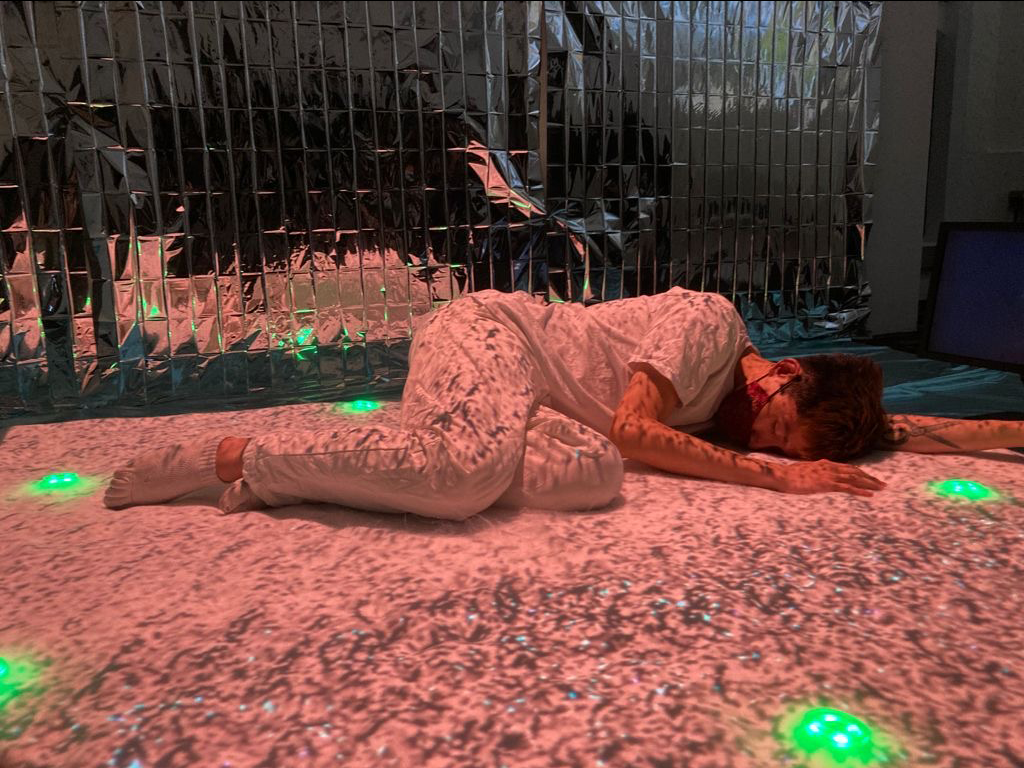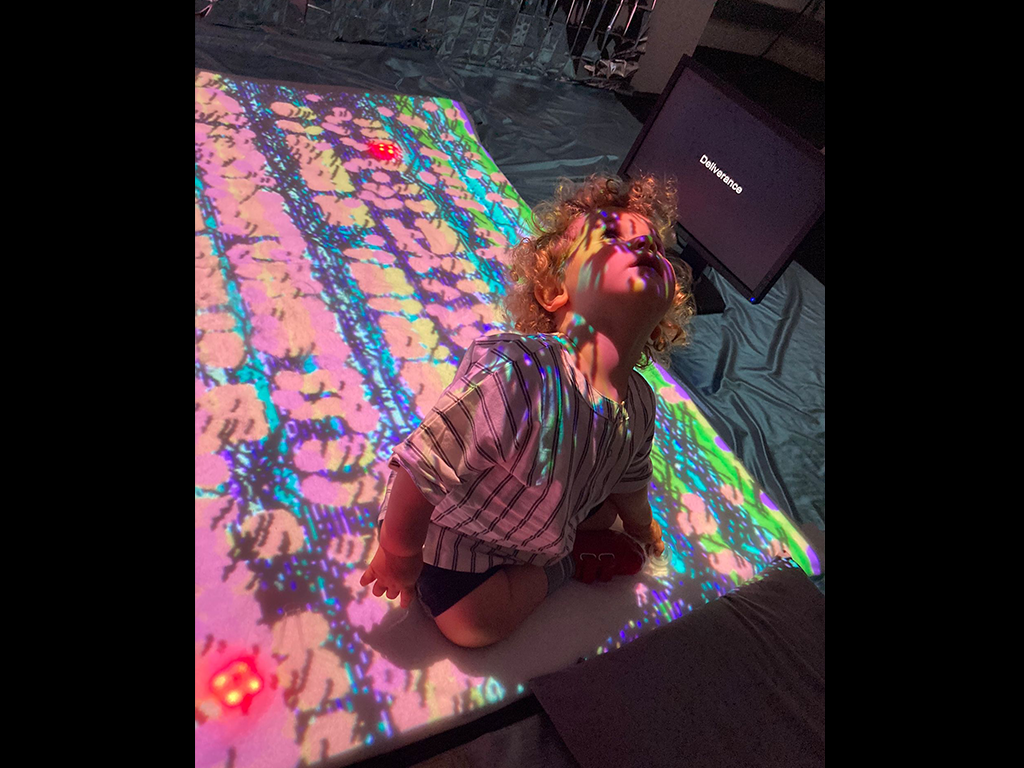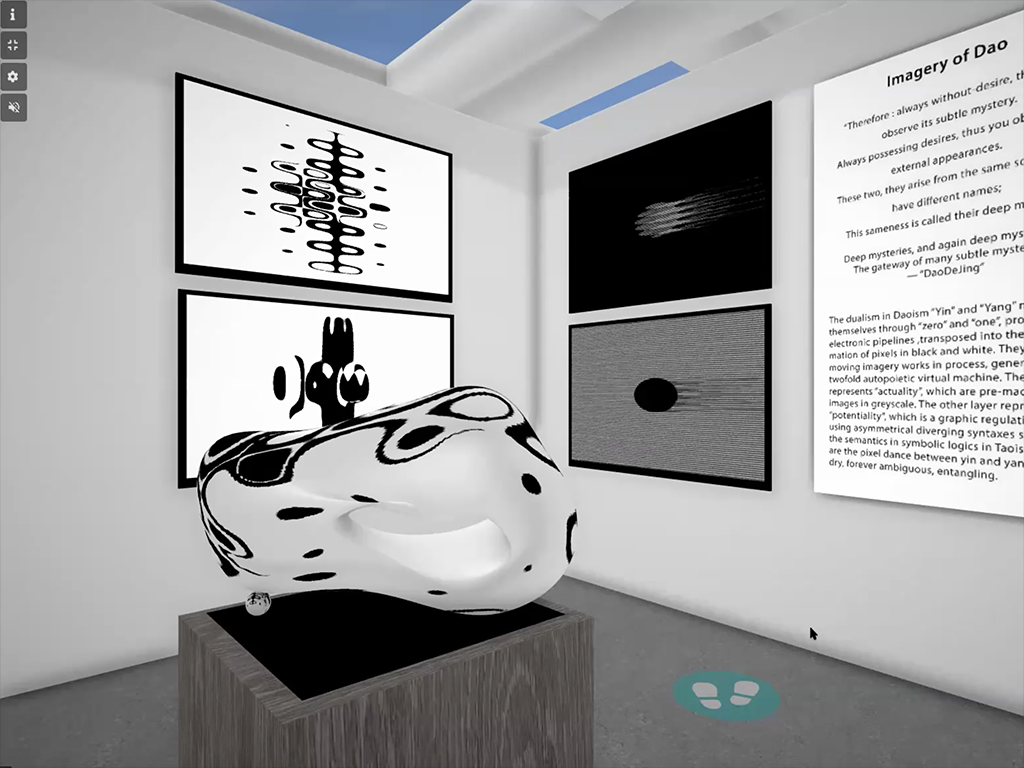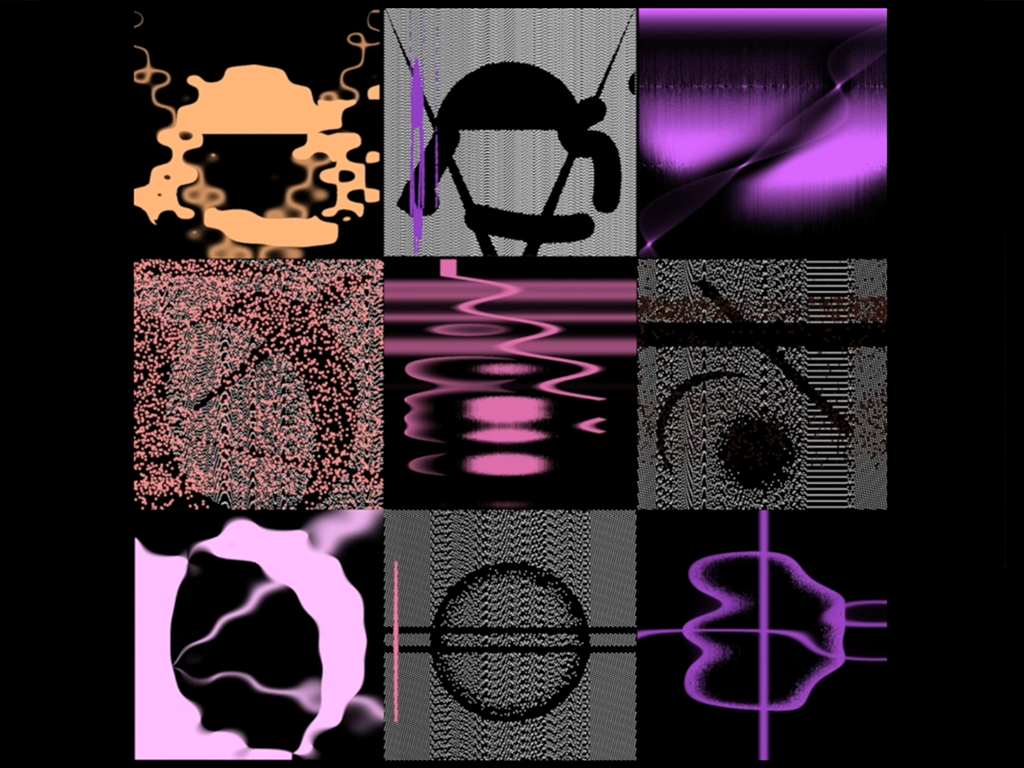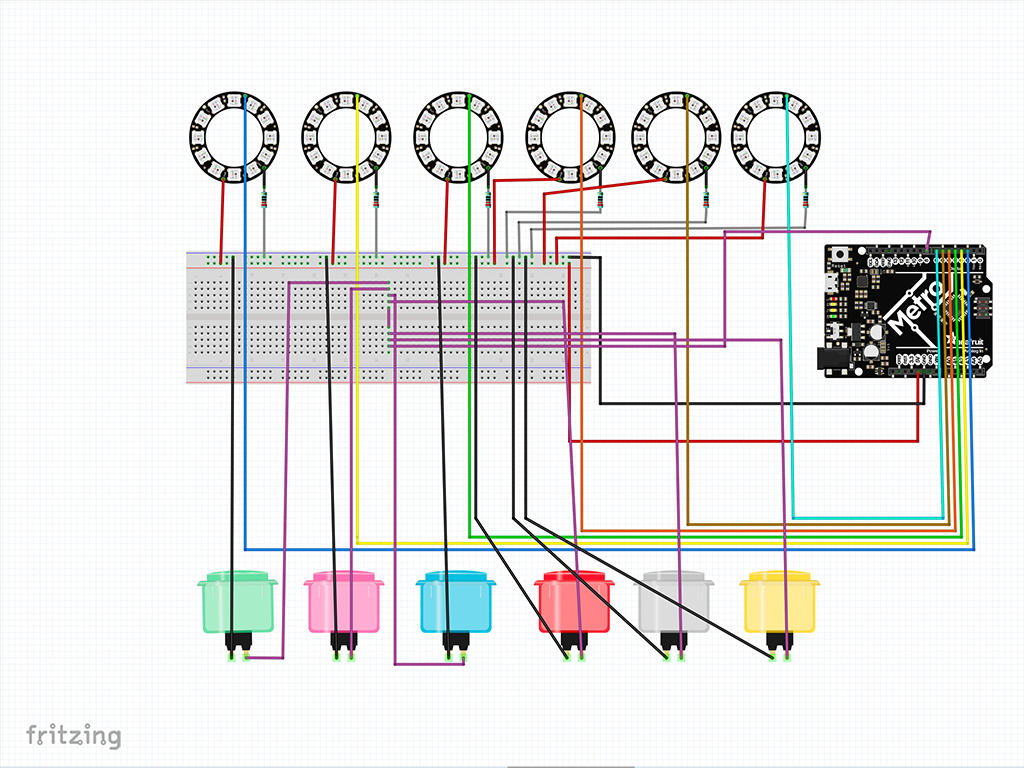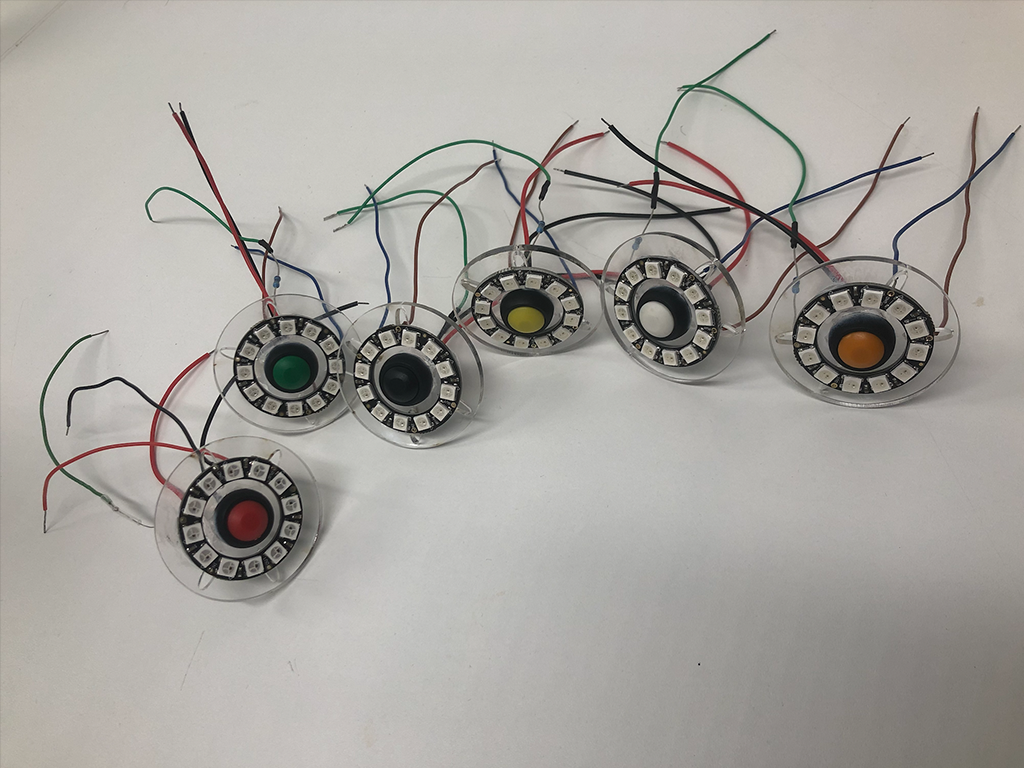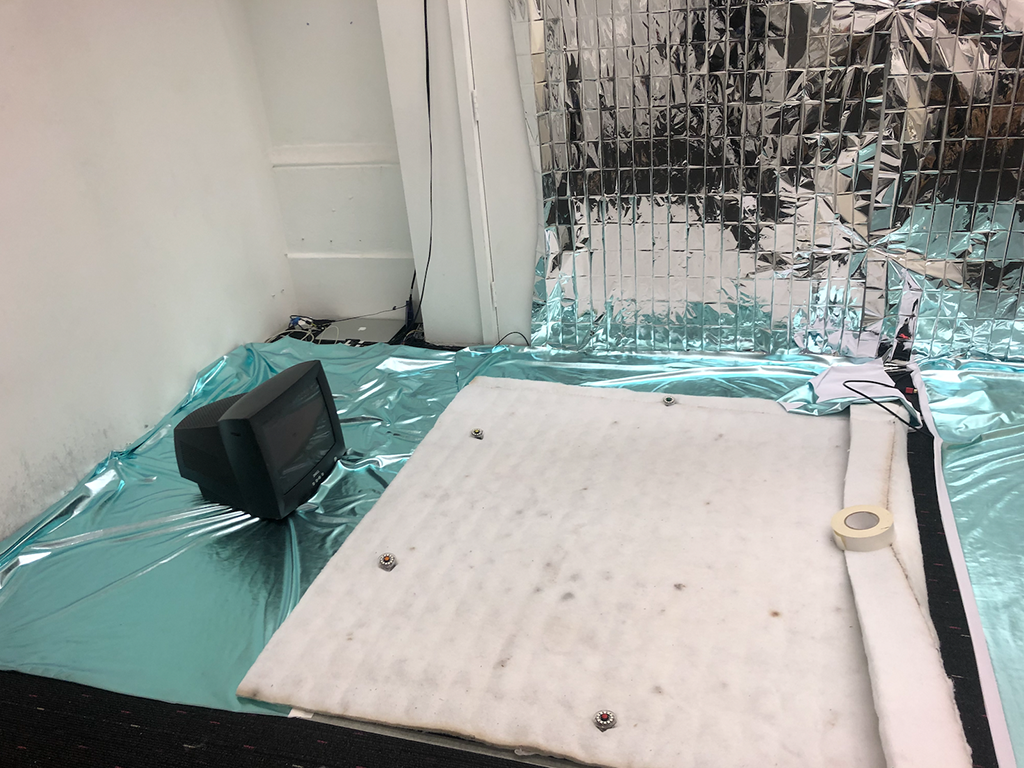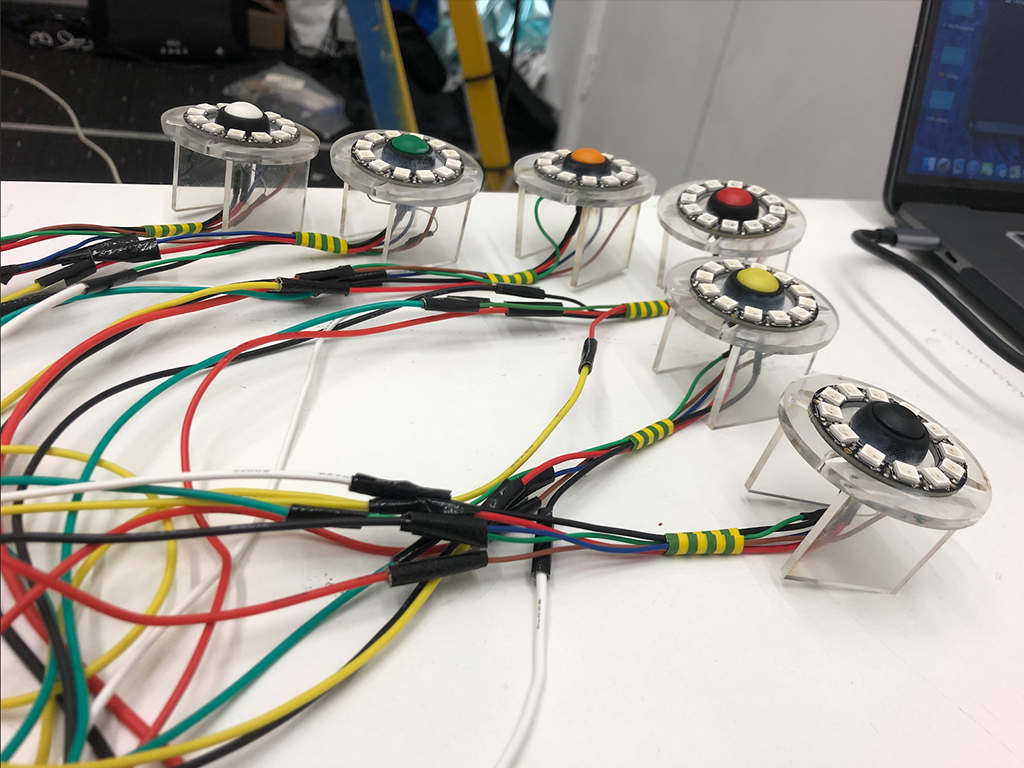The Poetry of Change
“The Poetry of Change” is an immersive interactive installation that simulates eastern shamanic ritual using symbols from Iching, interpretation of the symbols and 2D moving images to assemble space for meditation, purification and healing.
created by: Zhang,Yishuai
The Concept
“The Poetry of Change” is an immersive interactive installation that simulates eastern shamanic ritual using symbols from Iching[1], interpretation of the symbols and 2D moving images to assemble space for meditation, purification and healing. The three interconnected visual elements will be displayed on a retro CRT monitor, an LCD monitor and projected on the textile on the floor, respectively. The 2D moving images are generated by an image-processing system called Tao-machine from Yishuai's research “Tao-machine: Bridging Symbolic Logic from Iching and Computational Image-processing Syntaxes through the Model of Speculative Process Metaphysics”, which intends to yield an infinite possibilities of moving images represented by limited format of symbolism in Iching.
Immersed inside the light of the moving images, the audience can push the illuminating portal’s button on the ground, activating the spatial shift through the concurrent changes of all three visual elements. “The Poetry of Change” queers the overwhelmingly expanding info-sphere in modern society by using enveloped information in symbols ,their interpretations and colour dynamic as the signifiers and the signified, co-creating an immersive environment as being in the pure mode of aesthetic experience. By focusing on the processes of these changes, the threads of thinking are dissolved into a state of nothingness in constant flow, initiating the process of self-healing.
The Background
Research Background
This generative art project and research take forms in the analogous analysis between western process philosophical thoughts and Chinese Taoist symbolism as an analytic-interpretive strand to investigate self-engendering moving images as automation of “creativity”, which evokes the Taoist aesthetic called “confusion”. The twofold virtual system of Tao-machine is bifurcated into two interconnected subsystems representing “Actuality” and “Potentiality” in which “Potentiality” is computed as the regulating syntaxes guided by the semantics in Taoist symbolic logic. The art project “The Poetry of Change” produced by Tao-machine, arouses the aestheticization of this convergent model of both western speculative process metaphysics[2] and Taoist symbolism through a series of dynamic visual abstraction.
The combination of Taoist symbolism with western speculative process metaphysics enables a hybrid model that is further utilised as the theoretical framework to program a virtual machine – Tao-machine. Tao-machine becomes a critical medium that produces a series of moving images as the experimentation to explore a poetic and intuitively mystic aesthetic, which encompasses both Taoist aesthetic in the notion of “confusion” and the aesthetic evoked by Whitehead’s speculative metaphysics, the harmonisation and resonance of the abstractions of science with those of arts, ethics and religion. In this regard, an artwork titled “The Poetry of Change” is produced by Tao-machine as an exemplification to analyse and investigate this form of visual expression further in details.
With the help of Tao-machine, the ordinary and generally ignored daily objects are transformed into codified objects as moving images with infinite possibility in its dynamic and a sense of “confusion”. According to Taoist master Tchouang-Tseu, confusion is one of the most important components that constitutes Taoist aesthetic and ethics. Being confused means that the Taoist is not able to distinguish between the beautiful and the ugly, but the process that makes the beauty or the ugliness [3](Yip, 2004). Similarly, in western process-based thought, the essence of being is nothing other than the absolute potentiality of the whole change in its own dynamic and the transformational process compared to a momentary phenomenon frozen in space and time. Therefore, confusion is possibly only situated in the horizon of discrepancy and, by the same token, of in-differentiation and of equality value. Nevertheless, confusion is not equivalent to ambiguity as such blurred horizon but to entangled situatedness with potential elucidation from multiple perspectives. It recoils from direct confrontation and any potential occurrence of violence, yet once a particular elucidation is validated or invalidated, confusion resumes itself as a result of coincidence. Confusion makes it possible to see what as free and emancipatory from any rigorously determined order. Confusion enables care for all the beings regardless of the predetermined canon. As a consequence, we can thus engage ourselves into boundless openness, without discrimination and prejudice.
Artwork Background
The conception of “confusion leads to infinite openness and in-differentiation” in Taoist aesthetic has also been adopted by western sculptor Walter De Maria, painter Gerhard Richter and musician John Cage in their individual artistic approaches.
In De Maria’s sculptures titled “360 ̊ I Ching”, he directly replicates the forms of 64 hexagrams from Taoist symbolism and spread them on a huge red carpet across two galleries at Dia: Beacon. For De Maria, form in itself has a finite amount in combinations, materials and possibilities, however, when a subject is present, the possibilities become as endless as the question one can ask. The visually uniformed but slightly discrepant sculptures provide spectators with the first impression of both “singular” (oneness) and “confusion” (discrepancy), which engenders a poetic and intuitively mystic ambience. Unlike the directness in De Maria’s work, in John Cage’s “10000 things”, the notion of “confusion” and “in-differentiation” has been elevated to another level. Cage takes the finite combinations of instruments to an endless kaleidoscope of musical invention. The indeterminate performance and randomly combined notes, intervals and volumes evoke not only a sense of confusion but also a quality of in-differentiation that erases his ego and unleashes what he called the “divine unconscious”. In Cage’s own word “it is an oversimplification of the situation where we actually are, its infinite play of interpenetration shows the diversity of the empirical world.” Further more, when Gerhard Richter starts his painting performances called “Cage Painting”, it is John Cage’s music 10,000 things that inspires him to embrace the idea of openness as well as navigate the coincidence during his performances. He says “One can see, or rather hear, a great example in John Cage’s work of how extensively, cleverly, and sensitively he treats coincidence in order to make music out of it.”
In “The Poetry of Change”, the dynamic musical elements are replaced by moving pixels on the screen and the “oversimplicity” in performance is transformed into the direct visual reference of Taoist symbols. Within this scope, coincidence spawns in the in-differentiated horizon of confusion, yielding infinite visual outcomes at every brand new moment.
The Interaction
"The Poetry of Change” is introduced to the audience in two modes as intra-active mode and interactive mode.
Intra-active Mode
Distinct from interaction, the on-going reiterative intra-actions do not deflect responsibility, but rather facilitate the materialisation of the notion of individuality in the making of spacetimemattering[4]. A process of self-engendered mode through the changes of symbols, words and moving images is set as the default mode.
Interative Mode
A ritualistic performance will be introduced to audience, which is the performing mode of the work. Artist will use tokens and the interactive portals to alter the energy fields of the space by changing the portal’s light colours, while initiating different sequences of poems reading, rhythmic breathing and chanting.
The Design
Program Design
Tao-machine is a virtual image-processing machine created in Openframework, programmed in C++. It transforms still images to two sets of moving images called particle image and wave image using image arithmetic[4] and point operation[5] methodologies.
Space design
As an immersive interactive installation that simulates eastern shamanic ritual, the space is designed as an open area where the audience could physically engage with the work.
The dialogue happens between a CRT monitor displaying the signifier(symbols from Iching) and a LCD monitor displaying the signified(interpretation of the symbol in English word), which all together simulates the common info-sphere in our cultural and social life. The consequences of the dialogue is the moving image displayed on the textile between two monitors as an abstraction of the infinite possibilities.
The material choice of the textile turned from the original plan of using projection fabric to the new idea of using a thick cotton mattress. Compared to the clear projection with high fidelity on the projection fabric, the projection on the cotton mattress demonstrates a more granular and fuzzy visual effect that resembles the traditional Chinese rice paper, which easily arouse a feeling of calmness and peace. I hand sewed several pieces of cotton mattresses into a big one that can cover the display area projected from above.
Performance design
The performances take place twice a day during the 5-day exhibition, which intends to assemble space for mediation and healing. Artist will use tokens and the interactive portals to alter the energy fields of the space by changing the portal’s light colours, while initiating different sequences of poems reading, rhythmic breathing and chanting.
There are two aspects of the healing quality in “The Poetry of Change”.
First, immersed in the light of the moving images, the energy blockages (caused by traumas in different stages in our life) in our energy body will response to the constant flowing photons, potentially get loosen and removed with the right breathing methods. I have researched on human energy body which is related to the emission of bio-photons discovered by German scientist Fritz- Albert Popp. The materiality of our body could be frozen or condensed light, and we constantly emit those photons. Donna Haraway also indicates that sunshine is the best technology because its potential healing quality. I won’t talk too much about it here. But I will link to the essay if you are interested http://zhangyishuai.com/essay1.html
The other aspect is that 'The Poetry of Change’ is to provide opportunities for audience to detach all the information in the mind, reaching a state of nothingness or emptiness that could yield a healing quality. In modern society, depression, stress, anxiety.. are mostly induced by overthinking and over-processing all the information around us. It is truly significant for us to halt our mind, and just stay in the state of being, feeling and healing.
The Technical Process
There are two aspects of the technical processes in this project, which are the software technical aspect: programming of the Tao-machine, and the physical computing technical aspect: building the interactive portal system.
Programming the Tao-machine
For the programming of the Tao-machine, it is gradually programmed and improved during the second year of my MFA degree at Goldsmiths through the courses of two work-in-progress online shows and the final show “Shivers”. In the first work-in-progress show, Tao-machine is programmed to process any 2D images by dividing all the pixels into two groups of pixels namely Yin and Yang particles. Specific image-processing algorithms are designed to Yin and Yang particles respectively. At this stage, all images are only in black and white for the purpose to just focus on the moving dynamic of those pixels.
In the second work-in-progress show, Tao-machine is further improved with more functions and colours. Firstly, each symbol in Iching is linked to a specific combination of algorithms to process the images, outputting moving images in a spectrum of selected colours. During this process, I have tried different point operation and particles-driven algorithms to approach a multiplicity in the final outcomes. Secondly, all three visual elements (symbol, moving image and interpretation of the symbol as English word) are successfully interlinked for display on my laptop. Last but not least, the Tao-machine is enabled to output two sets of moving images called particle image and wave image. This approach is to adapt the artistic effects to the betterment of the conceptualisation of the whole project.
It is only until the final exhibition “Shivers” that Tao-machine reaches its full potential. In order to realise the infinite outputs of moving images driven by finite format in symbols, I have rigorously modified and tested all the underlying algorithms for the purpose to yield a multiplicity of visual representations. Besides, for the stability of the program, the Tao-machine was run for hours each day to debug any potential errors that could be neglected during the coding process. For example, I forget to give one parameter a default value in the “switch case” function. When certain transformation from one set of algorithms to another occurs, the program crashes with the debug information: EXP_BAD_ACCESS. Furthermore, I spent time in optimising the program by distributing computational calculations into both CPU and GPU to have a smoother visual transformation during the program run.
Building the interactive portal system
For the interactive aspect of the project, I intend to build a simple Button-Neopixel system which I called portal system. There are altogether 6 portals arranged in the shape of a hexagon, embedded in the textile on the floor. When one of them is pressed, all the six neopixel ring LEDs will change to a corresponding colours in the range of red, orange, yellow, green, blue and purple. Meanwhile, the button pressing signal will change a corresponding bar in the hexagram (symbol in Iching) displayed on the CRT monitor, hence changing the word displayed on the LCD monitor as well as the moving images projected on the textile.
The portal system consists of six Neopixel ring with 12 LEDs, six analogue buttons with springs and 6 resistors attached to the LED rings. The wiring details are shown in the Fritzing diagram below. Furthermore, each portal is designed as the form in which one button is placed inside one LED ring. I used laser cutting machine to build a simple support frame out of transparent acrylic board. With the supporting frame, each portal can stand independently within the textile, which enables a robust structure to be pressed during the performance.
To link the portal system to the Tao-machine program, I used serial-communication method between Arduino and Openframework. When each of the six buttons is pressed, Arduino will receive the signal and informs the program in Openframework to change the symbol. Each one of the buttons placed in the shape of a hexagon corresponds to each bar in the hexagram symbol. The button pressing will toggle the bar between intact state(Yang) and broken state(Yin). In order to reduce the latency between the moment when a button is pressed and when the symbol is changed, I tried using button edging detection method to deliver a smoother reaction from the button to the change of the symbol. However, the latency still occurs when more than one button are pressed at the same time or one right after another. Another time-consuming issue is the process of soldering and arranging wires from the differently placed portal to the Adafruit Metro Express board. With much dedication and attention to details, the portal system finally works well as expected.
For the multi-display on three different devices (one CRT retro monitor, one LCD monitor and one 1080i projector), I started with the method of generating 3 windows within one Openframework program and assign each window to a different display device. However, this method does not work out well, which causes an overloading of computational power. Then I tried to build three different programs in Openframework and used OSC message to allow the communication to happen between them. Theoretically and practically, this method might work out well. But I need to find two more computers or raspberry-Pi to drive the three separated programs independently, which could result in over-budget. Finally, I used the Matrox3HeadToGo converter to get signal from one computer, and separate them into three different devices. Because of the different display configurations of the three devices, it is important to adjust the original display ratio to a specific set-up that enables the visual content to be properly displayed. Luckily, this method works out really well as expected.
All in all, the physical installing part of the project is full of challenges, errors and trials. Nevertheless, when everything works out well, the feeling of achievement is stronger than ever. What I keep telling myself is to spare enough time for debugging phase and always try to be flexible to innovate alternative approaches in case something unexpected happens.
Curator Interview
During the exhibition "Shivers" 2021, I have had an amazing interview with Fiona Graf who is one of the postgraduate student in Art Curation Program. Here is the QR code linked to the interview content hosted online.
References
Code reference
1. Andy Lomas ,Computational Forms and Process, Course Example:particleLab8_stigmergy, particleLab3_noise
2. Matt Pearson, Generative Art
3. Denis Perevalov,Chapter 3, Mastering openframeword: Creative Coding Demystified
4. Denis Perevalov, Igor Tatarnikov, Openframework Essentials, P304 Multidisplay setup and sharing images between separate programs
5. OpenframeWork Example-Communication-serialExample
Literature reference
[1] Iching, also called Yijing or "The Book of Changes".The I Ching or Yi Jing (Chinese: 易經, Mandarin), usually translated as Book of Changes or Classic of Changes, is an ancient Chinese divination text and among the oldest of the Chinese classics.
[2] Speculative Process Metaphysics, is firstly coined by Alfred North Whitehead. In a nutshell, it is the on-going process of exploration and navigation to fill the gap between the known(science) and the unknown(metaphysics). The reason I used it is because that it bridges two most important elements that are the symbols from Iching(unknown) and image-processing syntaxes(known) in ‘Tao-machine’.
[3] Yip, Wai-Lim. 2004. Conversation with Wai-Lim Yip “Contemporary Art and Taoism”. Symposium, “Past in Reverse”. San Diego Art Museum.
[4]Spatiotemporal node is where Spacetimemattering take place. Spacetimemattering are forces in producing material-cultural worlds through the intra-actions between human and nonhuman (matter) that also recognizes that time is entangled with space and matter. Barad K: Meeting the universe halfway: quantum physics and the entanglement of matter and meaning. Duke University Press, Durham, NC, 2007.
[5] Image arithmetic applies one of the standard arithmetic operations or a logical operator to two or more images. The operators are applied in a pixel-by-pixel way, i.e., the value of a pixel in the output image depends only on the values of the corresponding pixels in the input images. Gholamreza Anbarjafari (Shahab), 2014, Digital Image Processing, University of Tartu. Chapter 7 Arithmetic and logic operations. https://sisu.ut.ee/imageprocessing/book/7
[6] A point operation is a modification to a pixel value which is based on that pixel value and is independent of location or neighbouring values. Arthur R. Weeks, 1996, Fundamentals of Electronic Image Processing, IEEE Press. https://academic.mu.edu/phys/matthysd/web226/L0129.htm
Image reference
[1] John Cage sketch, http://rosewhitemusic.com/piano/writings/ten-thousand-things/
[2] Walter de Maria, https://www.wsj.com/articles/walter-de-marias-i-ching-sculpture-comes-to-upstate-new-york-1461875773
[3]Gerhard Richter, Cage Painting, https://gagosian.com/exhibitions/2021/gerhard-richter-cage-paintings-new-york/
Special Thanks
SHISHI — for the music in my video
Jonas Grünwald & Keita Ikeda — for helping debug my codes
Robert Hall — for helping mount the projector
Camila Francesca, Ana Rodrigues Macedo , Duncan Paterson, Marlena Kepa, Timothy Lee, Veera Jussila, Yuxuan Liao and Xinyu Sun — for document my work
Baby Ruben — for being the loveliest audience playing around my work
































































